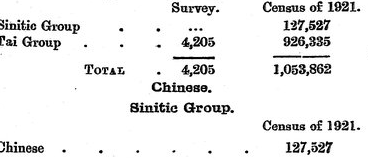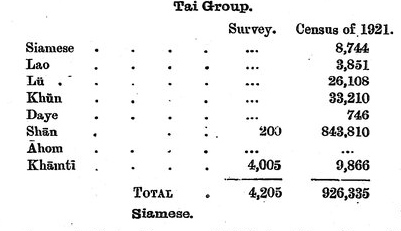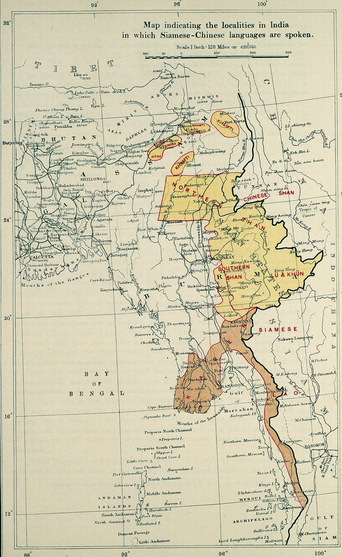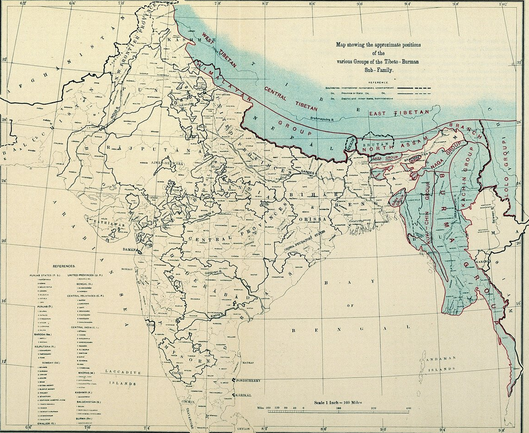The Siamese-Chinese Sub.Family of Indian Languages
This article has been extracted from |
NOTE: While reading please keep in mind that all articles in this series have been scanned from a book. Invariably, some words get garbled during Optical Recognition. Besides, paragraphs get rearranged or omitted and/ or footnotes get inserted into the main text of the article, interrupting the flow. As an unfunded, volunteer effort we cannot do better than this.
Readers who spot errors in this article and want to aid our efforts might like to copy the somewhat garbled text of this series of articles on an MS Word (or other word processing) file, correct the mistakes and send the corrected file to our Facebook page [Indpaedia.com] Complete volumes of the LSI are available on at least 3 websites (Joao, Archive, UChicago), against which errors can be checked and corrected.
Secondly, kindly ignore all references to page numbers, because they refer to the physical, printed book.
The Siamese-Chinese Sub.Family
The Siamese Chinese sub-family consists of two groupI,-the Sinitic and t he 'l'ai. The former includes Chinese, and, As explain above 1, perhaps Karen ,neither of which is dealt qith in the survey.Chinese
is nowhere a vernseular of British Iudia, although ua.tives of the Flowery Land are foWld iu nearly every largeeityas merchants. l!l,m leather-workers. carpenters, cane workers and the like. In Rangoon and Upper Burma there are considerable communities, but all are tempomry immigrants. who are either merchants that have come by sea, or else• pooplefrom yun –nan.
The Tai race, in its different branches, is beyond all question the most widely spreread Of any in the Indo-Chinese Peninsula. and it is certainly the m08t numerous. Its members are to be found from Assam to far into the Chinese Province of Kwang-si. and from Bangkok to the interior of Yun-nan. The history of its migration from YU,n-nan into southern Indo-China haS been already briefly •described2.' It remains to consider th evarious forms of speach used. by the nations of which it is composed.
Seven languages of the Tai group were recorded in t he Census,-Siamese, Lao, Lu, Khun, Daye, Shin, and Kluimti. Of these,
Only khamti and a stray dialects of Shan are found in the area subjected to the operation of these survey.So far as the census figures
Enumerate them , the others (except Ahom, which is a. dead language) were all found in British Burma. Excluding Khamti, these six Languages have no less t han seven different written characters and there are numerous dialects. The Siamese character, which was invented in the year 1125 is altogether different from the .others. The language, so far as British India is concerned is spokcn . principally in the Amherst and Mergui District of Burma. Lao, a dialect of Siamese, is widely spoken iu Siam, and in Burma is found in the Amherst District .. bordering on that country. It has an a alphabet of its own, borrowed from that of MOn. Lu and Khun have alphabets closely related to that of Lao. They are spoken in the Kengtung shan State, just north of the saimese frontier. they are•forms of speech intermediate between Siamese and Shan. Daye is spoken by a few people in t he Southern Shan state. I know nothing about it.
Shan proper is spoken all over the Shan. States, both 'British and.Chinese, as far north as Mogaung, aud also in. the country to their -north• west. It has a. northern, a southern, and. a Chinese dialect, the last having a slightly different written character, whioh, like all the other Shan alphabets, is borrowed from Burmese. The word" Shan," or, as sounded, "Shan, " is the Burmese pronunciation of "Sham," which is the correct form. and which reappears in the final. syllable of" Assam." As this Survey did not cover the Shan. StateS, the only example of the language across which it came, was the Aiton dialect spoken by some 200 immigrants to Assam. 'these will be mentioned again lower down.
In the year 1228 A..D., just about the time when Kublai Khan was establishing himself in China, a Shan tribe, the Ahoms, entered the country now called Assam. where they settled and to which -they ultimately gave their name .ahom' being but a variant pronunciation of Asam.
They gradually establiahed their power, which reached its culminating point in their victory over the Kachiiris of Dimapur in 1540. This made them masters of the whole of the Assam Valley. and they continued to rule their territories with vigour and suceess up to the end of the seventeenth century, when they became infected with Hinduism. They lost their pride of race. their habits change and instead of being like barbarians, but mighty Kshatriyas, they become, like Brahmans, powerful in talk alone.' They gradually declined in strength, and Assam, after being first con• -querod by the Burmese, was finally annexed. by the British in 1824. So completely Hindus did they become before their final fall, that their language has boon dead for centuries, and is now known only by a few priests who have remained. faithful to their old traditions. Ahom is an old form of the language ,vhich ultimately became Shan, and it is of great importance for the study of the mutual relationship of the variousTai languages.
It is curious that, in spite of their long domination, the .Ahoms have left so few Traces of their influence on the languages of the Assam Valley. They appear to have •been throughout few in number, and, as their rule extended over various tribes speaking different forms of speech, the necessity of a lingua franca soon became apparent. This could only have been either Ahom or Assamese. The latter, being an Aryan language, possessed the greater vitality, and its use was no doubt encouraged. by the Hindu. priests who acquired influence over the ruling race. That influence alone would not have been sufficient, for we shall see how in Afanipur, where Hinduism was .enthusiastically accepted, the people have still retained. their language, although the Brahmans have had to invent a writtern character iu which to record it. Although the Ahoms have left so few traces on the language of Assam, they have nevectheless laid their mark upon its literature. One of the few Ahow words used at the present day is buranji ,the store of instruction for the ignorant,' as they called history, and it is to them that Asssm owes the historical sense which created the series of• chronicles, still called by their old foreign name, that are the pride of ite literature.
When Mogaung was conquered. by Alomphra., a number of Shans migrated north, And settled here and there in the country round the upper courses of the Chindwin and Regarding the ahom burajis ,see sir Edward Gait’s history of assam ,pp. Xff(2nd edition).
The Irrawaddy. Their principal sattlement was high up on the latter river in the country known as Kham-ti Long or "Great Khamti-land.
Thence some of them were invited by their kinsmen, the.Ahoms, and settled. in Eastern Assam, where they ultimately ousted their former hosts. They have developed a slightly varyivg dialect of Shan, and have an alphabet of their own.
Since then small numbers of other Shan tribes have migrated. into Assam, who are known as phakials, Tai-rongs (locally called. Turungs), Nom. and Aitons. The last-named. still speak Burmese Shan, and use that alpbabet. Two hundred of them where counted in the operations of this Survey. The Tai-ronge were enslaved by the K achins en route, and all. or nearly all, now spellk Singpho, the language of their .masters . A few of them, together with the phakials and the Noras, speak a. Shan. Dialect, differences little, it at all. from Khamti.



